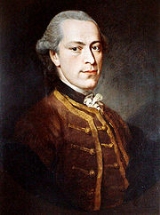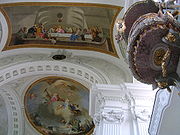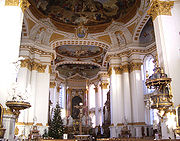
Januarius Zick
Encyclopedia
Johann Rasso Januarius Zick (6 February 1730 – 14 November 1797) was a painter and architect. He is considered to be one of the main masters of the Late-Baroque
.




and began to learn his trade from his father, Johannes Zick
, a renowned painter himself, to whom he was apprenticed in order to learn how to paint fresco
es. In 1744, when Januarius Zick was fourteen years old, his brother, three years his junior, fell to his death from a scaffolding in Weingarten. From 1745 to 1748, Januarius Zick was apprenticed as a bricklayer
to Jakob Emele in Schussenried
. Having finished his apprenticeship, he worked, together with his father, at the residence of the Prince-Bishop of Würzburg
and then, until the mid-1750s, at the residence of the Prince-Bishop of Speyer
in Bruchsal
.
In 1756, Januarius Zick went to Paris
for further education. There, he came into contact with artists and art connoisseurs from Rome
, Basel
and Augsburg
, who broadened his horizon concerning his art and had a considerable influence on him.
After having furnished Castle Engers near Neuwied
with frescoes in 1760, he was appointed court painter
to the Prince-Elector
of Trier
, the archbishop
of Trier. He married in Ehrenbreitstein and settled there.
After 1774, he also designed intarsia
paintings for cabinet maker
David Roentgen.
From the late 1770s on, Januarius Zick was very active in Upper Swabia
, furnishing a number of monastery
churches and parish church
es with frescoes and altarpiece
s.
After the mid-1780s until his death, he was productive in the territories of the Prince-Elector of Trier and the Prince-Elector of Mainz
.
He died in Ehrenbreitstein.
Baroque
The Baroque is a period and the style that used exaggerated motion and clear, easily interpreted detail to produce drama, tension, exuberance, and grandeur in sculpture, painting, literature, dance, and music...
.




Life
Januarius Zick was born in MunichMunich
Munich The city's motto is "" . Before 2006, it was "Weltstadt mit Herz" . Its native name, , is derived from the Old High German Munichen, meaning "by the monks' place". The city's name derives from the monks of the Benedictine order who founded the city; hence the monk depicted on the city's coat...
and began to learn his trade from his father, Johannes Zick
Johannes Zick
Johannes Zick was a German painter of frescoes in southern Germany and active during the Baroque period...
, a renowned painter himself, to whom he was apprenticed in order to learn how to paint fresco
Fresco
Fresco is any of several related mural painting types, executed on plaster on walls or ceilings. The word fresco comes from the Greek word affresca which derives from the Latin word for "fresh". Frescoes first developed in the ancient world and continued to be popular through the Renaissance...
es. In 1744, when Januarius Zick was fourteen years old, his brother, three years his junior, fell to his death from a scaffolding in Weingarten. From 1745 to 1748, Januarius Zick was apprenticed as a bricklayer
Bricklayer
A bricklayer or mason is a craftsman who lays bricks to construct brickwork. The term also refers to personnel who use blocks to construct blockwork walls and other forms of masonry. In British and Australian English, a bricklayer is colloquially known as a "brickie".The training of a trade in...
to Jakob Emele in Schussenried
Bad Schussenried
Bad Schussenried is a town in Upper Swabia in the district of Biberach, Baden-Württemberg, Germany.It lies on the Upper Swabian Baroque Route.Schussenried Abbey, a former monastery founded in 1183, is located in Bad Schussenried...
. Having finished his apprenticeship, he worked, together with his father, at the residence of the Prince-Bishop of Würzburg
Würzburg Residence
The Würzburg Residence is a palace in Würzburg, southern Germany. Johann Lukas von Hildebrandt and Maximilian von Welsch, representants of the Austrian/South German Baroque were involved in the construction, as well as Robert de Cotte and Germain Boffrand, who were followers of the French Style...
and then, until the mid-1750s, at the residence of the Prince-Bishop of Speyer
Speyer
Speyer is a city of Rhineland-Palatinate, Germany with approximately 50,000 inhabitants. Located beside the river Rhine, Speyer is 25 km south of Ludwigshafen and Mannheim. Founded by the Romans, it is one of Germany's oldest cities...
in Bruchsal
Bruchsal
Bruchsal is a city at the western edge of the Kraichgau, approximately 20 km northeast of Karlsruhe in the state of Baden-Württemberg, Germany...
.
In 1756, Januarius Zick went to Paris
Paris
Paris is the capital and largest city in France, situated on the river Seine, in northern France, at the heart of the Île-de-France region...
for further education. There, he came into contact with artists and art connoisseurs from Rome
Rome
Rome is the capital of Italy and the country's largest and most populated city and comune, with over 2.7 million residents in . The city is located in the central-western portion of the Italian Peninsula, on the Tiber River within the Lazio region of Italy.Rome's history spans two and a half...
, Basel
Basel
Basel or Basle In the national languages of Switzerland the city is also known as Bâle , Basilea and Basilea is Switzerland's third most populous city with about 166,000 inhabitants. Located where the Swiss, French and German borders meet, Basel also has suburbs in France and Germany...
and Augsburg
Augsburg
Augsburg is a city in the south-west of Bavaria, Germany. It is a university town and home of the Regierungsbezirk Schwaben and the Bezirk Schwaben. Augsburg is an urban district and home to the institutions of the Landkreis Augsburg. It is, as of 2008, the third-largest city in Bavaria with a...
, who broadened his horizon concerning his art and had a considerable influence on him.
After having furnished Castle Engers near Neuwied
Neuwied
Neuwied is a town in the north of the German state of Rhineland-Palatinate, capital of the District of Neuwied. Neuwied lies on the right bank of the Rhine, 12 km northwest of Koblenz, on the railway from Frankfurt am Main to Cologne...
with frescoes in 1760, he was appointed court painter
Court painter
A court painter was an artist who painted for the members of a royal or noble family, sometimes on a fixed salary and on an exclusive basis where the artist was not supposed to undertake other work. Especially in the late Middle Ages, they were often given the office of valet de chambre...
to the Prince-Elector
Prince-elector
The Prince-electors of the Holy Roman Empire were the members of the electoral college of the Holy Roman Empire, having the function of electing the Roman king or, from the middle of the 16th century onwards, directly the Holy Roman Emperor.The heir-apparent to a prince-elector was known as an...
of Trier
Trier
Trier, historically called in English Treves is a city in Germany on the banks of the Moselle. It is the oldest city in Germany, founded in or before 16 BC....
, the archbishop
Archbishop
An archbishop is a bishop of higher rank, but not of higher sacramental order above that of the three orders of deacon, priest , and bishop...
of Trier. He married in Ehrenbreitstein and settled there.
After 1774, he also designed intarsia
Intarsia
Intarsia is a form of wood inlaying that is similar to marquetry. The term is also used for a similar technique used with small, highly polished stones set in a marble matrix .- History :...
paintings for cabinet maker
Cabinet making
Cabinet making is the practice of using various woodworking skills to create cabinets, shelving and furniture.Cabinet making involves techniques such as creating appropriate joints, dados, bevels, chamfers and shelving systems, the use of finishing tools such as routers to create decorative...
David Roentgen.
From the late 1770s on, Januarius Zick was very active in Upper Swabia
Upper Swabia
Upper Swabia is a region in Germany in the federal states of Baden-Württemberg and Bavaria. The name refers to the area between the Swabian Alb, Lake Constance and the Lech...
, furnishing a number of monastery
Monastery
Monastery denotes the building, or complex of buildings, that houses a room reserved for prayer as well as the domestic quarters and workplace of monastics, whether monks or nuns, and whether living in community or alone .Monasteries may vary greatly in size – a small dwelling accommodating only...
churches and parish church
Parish church
A parish church , in Christianity, is the church which acts as the religious centre of a parish, the basic administrative unit of episcopal churches....
es with frescoes and altarpiece
Altarpiece
An altarpiece is a picture or relief representing a religious subject and suspended in a frame behind the altar of a church. The altarpiece is often made up of two or more separate panels created using a technique known as panel painting. It is then called a diptych, triptych or polyptych for two,...
s.
After the mid-1780s until his death, he was productive in the territories of the Prince-Elector of Trier and the Prince-Elector of Mainz
Archbishopric of Mainz
The Archbishopric of Mainz or Electorate of Mainz was an influential ecclesiastic and secular prince-bishopric in the Holy Roman Empire between 780–82 and 1802. In the Roman Catholic Church hierarchy, the Archbishop of Mainz was the primas Germaniae, the substitute of the Pope north of the Alps...
.
He died in Ehrenbreitstein.
Works
- 1760 - Castle Engers, frescoes
- 1778 until 1781 - BenedictineBenedictineBenedictine refers to the spirituality and consecrated life in accordance with the Rule of St Benedict, written by Benedict of Nursia in the sixth century for the cenobitic communities he founded in central Italy. The most notable of these is Monte Cassino, the first monastery founded by Benedict...
church, Wiblingen AbbeyWiblingen AbbeyWiblingen Abbey was a former Benedictine abbey which was later used as barracks. Today its buildings house several departments of the medical faculty of the University of Ulm. The former abbey is located south of the confluence of the rivers Danube and Iller, south of the city of Ulm in the German...
, painter and interior designer - 1780 - Parish church ZellRiedlingenRiedlingen is a town in the district of Biberach, Baden-Württemberg, in the south-west of Germany. It is one of the destinations of the Upper Swabian Baroque Route. There are ca. 10,000 inhabitants.- Geography :...
(Riedlingen) - 1782 - Parish church Dürrenwaldstetten
- 1782/83 - Benedictine monastery church OberelchingenElchingenElchingen is a municipality about 7 km east of Ulm–Neu-Ulm in the district of Neu-Ulm in Bavaria, GermanyMunicipality parts:* Thalfingen: 4 211 residents, 8.83 km²* Oberelchingen: 3 024 residents, 7.31 km²...
near UlmUlmUlm is a city in the federal German state of Baden-Württemberg, situated on the River Danube. The city, whose population is estimated at 120,000 , forms an urban district of its own and is the administrative seat of the Alb-Donau district. Ulm, founded around 850, is rich in history and... - 1784 - PremonstratensianPremonstratensianThe Order of Canons Regular of Prémontré, also known as the Premonstratensians, the Norbertines, or in Britain and Ireland as the White Canons , are a Catholic religious order of canons regular founded at Prémontré near Laon in 1120 by Saint Norbert, who later became Archbishop of Magdeburg...
monastery church Rot an der Rot AbbeyRot an der Rot AbbeyRot an der Rot Abbey was a Premonstratensian monastery in Rot an der Rot in Upper Swabia, Baden-Württemberg, Germany. It was the first Premonstratensian monastery in the whole of Swabia... - 1785 - Residence of the Prince-Elector of TrierElectoral Palace (Koblenz)The Electoral Palace in Koblenz, Germany was the residence of the last Archbishop and Elector of Trier, Clemens Wenceslaus of Saxony, who commissioned the building of the castle by the end of the 18th Century...
in Koblenz, fresco painter - 1786 - Church St IgnatiusIgnatiusIgnatius is a male given name of presumed Latin or Etruscan origin, believed to mean "fiery one".It may refer to:-Given name:*Ignatius Kutu Acheampong , Ghanaian military ruler*Ignatius Bonomi , British architect...
and office of cathedral provost in MainzMainzMainz under the Holy Roman Empire, and previously was a Roman fort city which commanded the west bank of the Rhine and formed part of the northernmost frontier of the Roman Empire... - 1786 - AugustinianAugustiniansThe term Augustinians, named after Saint Augustine of Hippo , applies to two separate and unrelated types of Catholic religious orders:...
monastery church TriefensteinTriefensteinTriefenstein is a market community in the Main-Spessart district in the Regierungsbezirk of Lower Franconia in Bavaria, Germany.- Location :Triefenstein lies in the Würzburg Region.... - 1787 - Prince-Elector's CastleElectoral Palace Mainz250 px|thumb|The Electoral Palace, from the southThe Electoral Palace in Mainz is the former city Residenz of the Archbishop of Mainz, who was also Prince-Elector of his electoral state within the Holy Roman Empire...
in Mainz - 1790 - Court church in KoblenzKoblenzKoblenz is a German city situated on both banks of the Rhine at its confluence with the Moselle, where the Deutsches Eck and its monument are situated.As Koblenz was one of the military posts established by Drusus about 8 BC, the...
, altarpiece - 1792 and 1793 - Representative buildings in Frankfurt am MainFrankfurtFrankfurt am Main , commonly known simply as Frankfurt, is the largest city in the German state of Hesse and the fifth-largest city in Germany, with a 2010 population of 688,249. The urban area had an estimated population of 2,300,000 in 2010...
, Palace Schweitzer and Russischer Hof

